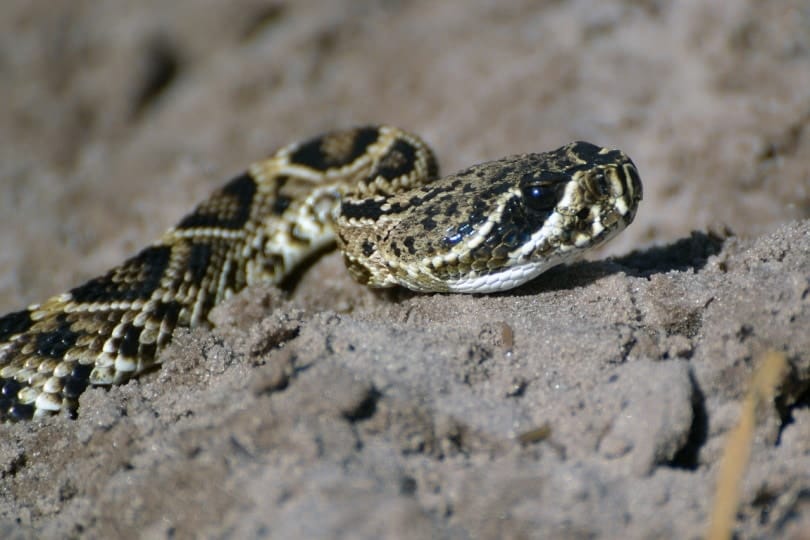While there are 37 different snake species throughout North Carolina, there are only six that you need to worry about. The other 31 species are non-venomous, even if their bite can be a bit painful.
Since there are so many different snake species in the state, you can find them in a wide array of habitats, from lakes to forests, so keep an eye out! If you’re curious about what’s out there, we’ve highlighted all the venomous species and four other ones that you might spot.

The 10 Snakes Found in North Carolina
1. Eastern Diamondback Rattlesnake
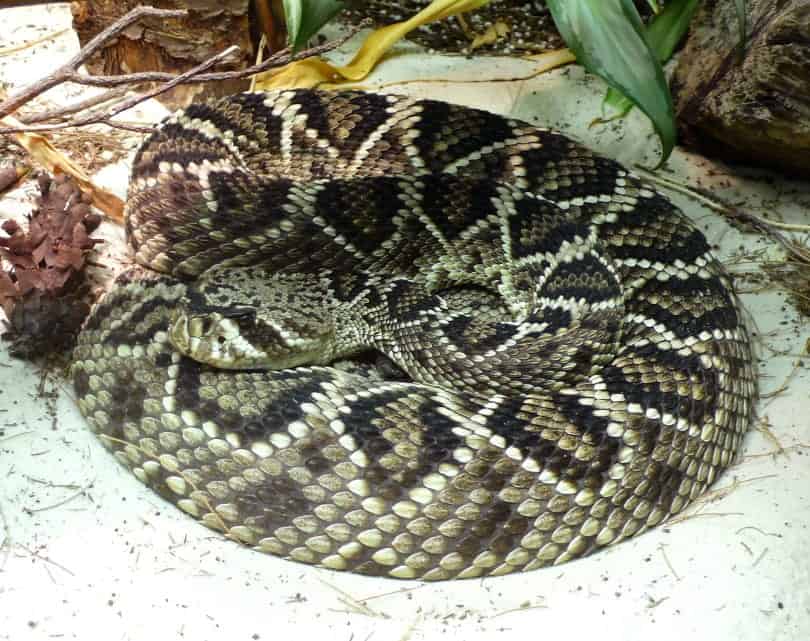
| Species: | Crotalus adamanteus |
| Longevity: | 15 to 20 years |
| Good to own as a pet?: | No |
| Legal to own?: | Yes |
| Adult size: | 4 to 5 feet |
| Diet: | Rats, mice, squirrels, birds, and rabbits |
Rattlesnakes are no joke, and the eastern diamondback rattlesnake is no exception. This is an extremely aggressive snake, but they are protected in the state of North Carolina.
However, if you’re worried about running into an eastern diamondback rattlesnake on your next walk in North Carolina, the chances are extremely slim.
Many experts believe that the snake is currently extirpated from the state, although nothing is stopping them from making a comeback in the future.
If you do spot an eastern diamondback rattlesnake in the wild, conservationists would like to know, but it’s a good idea to leave them alone.
2. Timber Rattlesnake
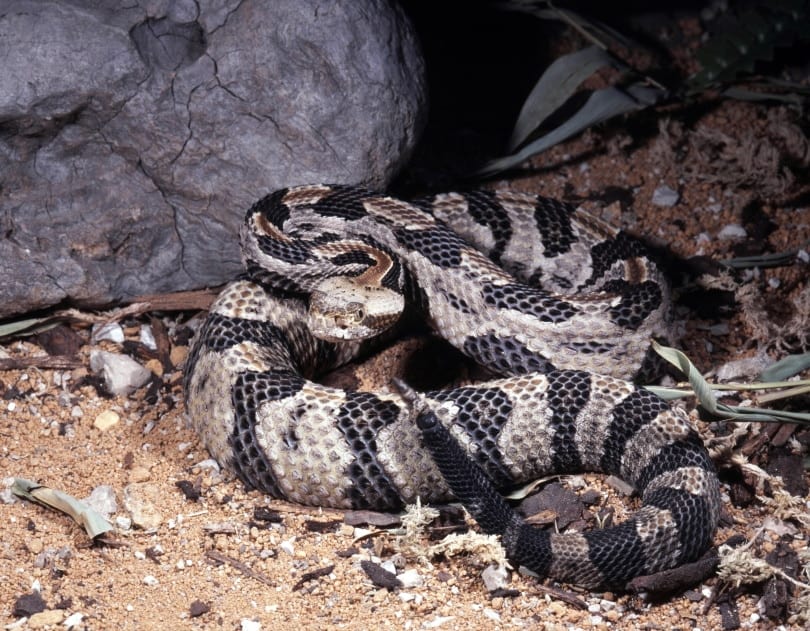
| Species: | Crotalus horridus |
| Longevity: | 10 to 20 years |
| Good to own as a pet?: | No |
| Legal to own?: | Yes |
| Adult size: | 2.5 to 5 feet |
| Diet: | Mice, rats, shrews, chipmunks, squirrels, birds, lizards, and amphibians |
A protected venomous snake in North Carolina is the timber rattlesnake. Their conservation status is currently listed as “least concern,” which means their population in the wild is decreasing at a slow rate.
Still, just like the eastern diamondback, the timber rattlesnake is a species that you should leave alone in the wild.
They’re opportunistic feeders and will eat just about any small animal that they can fit their mouth around. For a fully grown 5-foot snake, that opens up quite a few possibilities.
3. Carolina Pygmy Rattlesnake
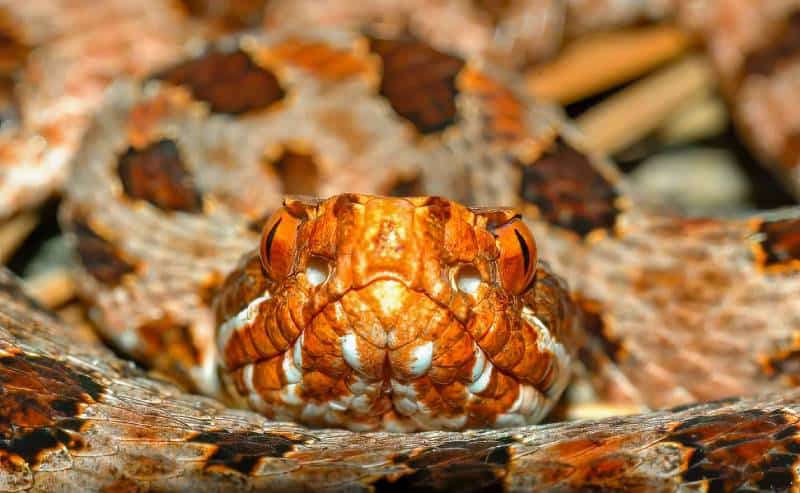
| Species: | Sistrurus miliarius |
| Longevity: | 20 years |
| Good to own as a pet?: | No |
| Legal to own?: | Yes |
| Adult size: | 1 to 2 feet |
| Diet: | Small mammals, birds, lizards, amphibians, and large insects |
The third rattlesnake that you might run across in North Carolina is the Carolina pygmy rattlesnake. Like the other two snakes, the pygmy is a protected species in North Carolina, which means if you find one in the wild, you should leave it alone.
The current conservation status of the Carolina pygmy rattlesnake is “least concern,” which means the population is shrinking but not at an alarming rate. The Carolina pygmy rattlesnake is the smallest rattlesnake in the state, but it’s still extremely venomous.
They eat smaller reptiles and mammals and will chow down on larger insects too.
4. Eastern Coral Snake

| Species: | Micrurus fulvius |
| Longevity: | 5 to 7 years |
| Good to own as a pet?: | No |
| Legal to own?: | Yes |
| Adult size: | 1.5 to 3 feet |
| Diet: | Lizards, frogs, and smaller snakes |
The eastern coral snake is a venomous snake that you need to look out for in North Carolina. But while they certainly live in the state, the chances of you encountering one is slim.
There have only been a few confirmed sightings in the southeast portion of North Carolina. To identify a coral snake, you can make use of the common rhyme, “Red touch black, safe for Jack. Red touches yellow, kills a fellow.”
But despite the tragic ending of the rhyme, there have been zero confirmed deaths as the result of a coral snake in the United States. They simply don’t inject enough venom with a single bite. As long as you don’t let them chew on you, you should be fine.
5. Copperhead
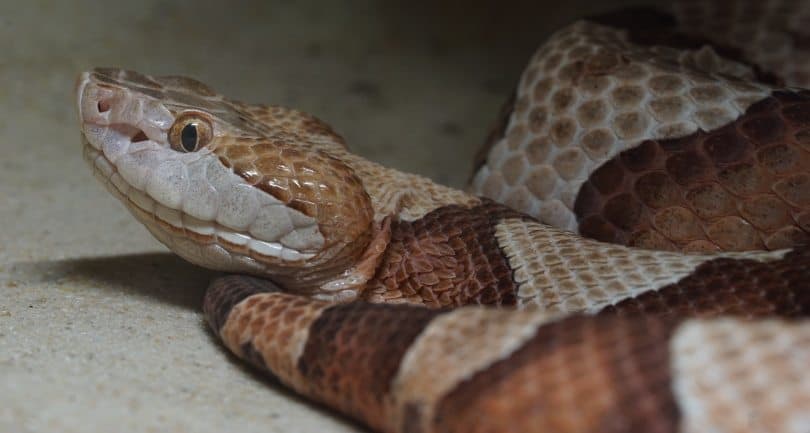
| Species: | Agkistrodon contortirx |
| Longevity: | 15 to 20 years |
| Good to own as a pet?: | No |
| Legal to own?: | Yes |
| Adult size: | 2 to 3 feet |
| Diet: | Mice, birds, lizards, small snakes, amphibians, and large insects |
While the copperhead might not be the largest snake out there, they are one of the most venomous. Fortunately, if you know what you’re looking for, they’re easy to identify.
They have a distinct Hershey Kiss marking along their patterned skin, and it’s something that you should familiarize yourself with if you live in North Carolina. The copperhead is the most common venomous snake that you’ll encounter in the state.
If you do get bit by a copperhead, you’ll need to seek medical attention as soon as possible. While it’s unlikely that they’ll inject enough venom to kill you, they certainly could.
6. Cottonmouth

| Species: | Agkistrodon piscivorus |
| Longevity: | 10 to 20 years |
| Good to own as a pet?: | No |
| Legal to own?: | Yes |
| Adult size: | 2 to 4 feet |
| Diet: | Fish, mice, squirrels, chipmunks, amphibians, and reptiles |
Rounding out the list of venomous snakes in North Carolina is the cottonmouth, also commonly referred to as the water moccasin. You can often find these snakes in freshwater streams and lakes, and they can reach an impressive 4 feet in length.
You can tell if you’ve spotted a cottonmouth by looking for a Hershey Kiss pattern on their skin. While this pattern is more pixelated than that of a copperhead, it’s still a sure sign that you need to leave the snake alone.
The cottonmouth can also reach larger sizes than most water snakes, although this isn’t a foolproof way to tell, as you could always be dealing with an adolescent snake.
7. Carolina Watersnake
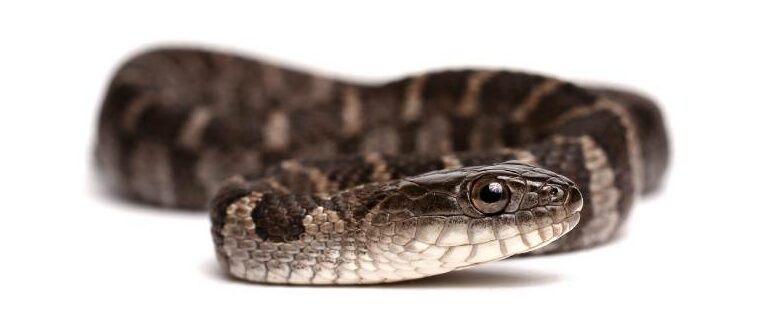
| Species: | Nerodia sipedon williamengelsi |
| Longevity: | 7 to 10 years |
| Good to own as a pet?: | Yes |
| Legal to own?: | Yes |
| Adult size: | 2 to 3 feet |
| Diet: | Fish and amphibians |
The chances are that a snake that you run into in North Carolina won’t have an ounce of venom. One such snake that you might encounter is the Carolina water snake. They are dark in appearance and are the most common water snake in North Carolina.
As they spend most of their time in or near the water, their diet consists primarily of fish and amphibians, but like most snakes, they’re opportunistic feeders.
They make great pets, but don’t expect them to live as long as many other snakes out there.
8. Outer Banks Kingsnake
| Species: | Lampropeltis getula sticticeps |
| Longevity: | 10 to 15 years |
| Good to own as a pet?: | Yes |
| Legal to own?: | Yes |
| Adult size: | 3 to 5 feet |
| Diet: | Smaller snakes, lizards, rodents, birds, and eggs |
One snake that you might come across in North Carolina is the Outer Banks kingsnake. These massive snakes can grow up to 5 feet in length, making them one of the largest native snakes in North America.
They also make great pets because they’re usually docile and eventually get used to handling. Just keep in mind that they can bite when they feel threatened.
In the wild, they have a varied diet, but in captivity, they can thrive off a mice- or rat-only diet.
9. Smooth Green Snake
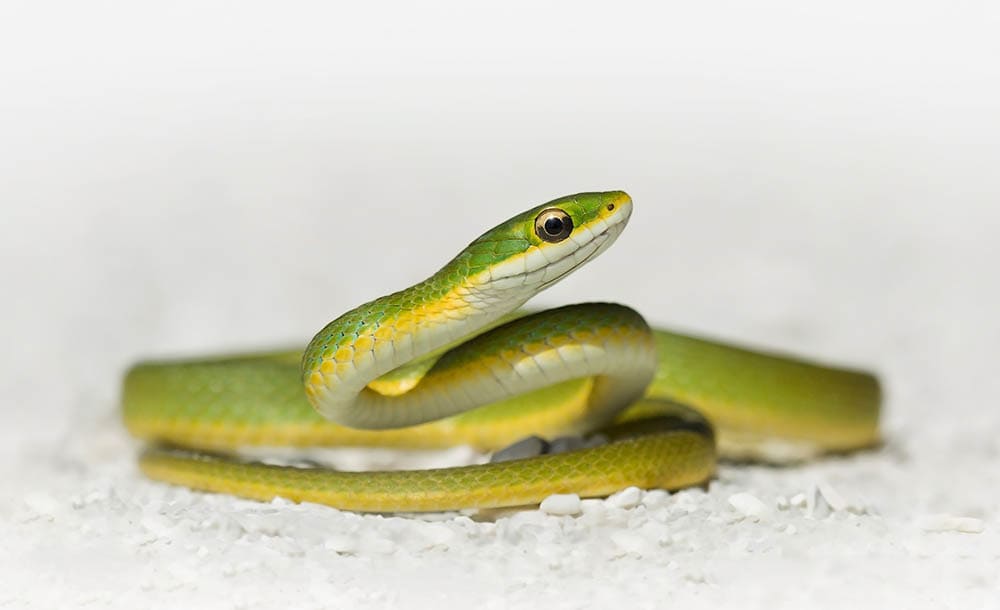
| Species: | Opheodrys vernalis |
| Longevity: | 15 to 20 years |
| Good to own as a pet?: | Yes |
| Legal to own?: | Yes |
| Adult size: | 2.5 to 3 feet |
| Diet: | Insects and amphibians |
One of the simplest snakes that you can find in North Carolina is the smooth green snake. As their name implies, they’re entirely green in color, but despite their 3-foot length, they’re not nearly as large as some other snakes.
They have a much skinnier body, and this is in large part due to their diet. Unlike many snakes that eat mammals, rodents, birds, and similar creatures, the smooth green snake is an insectivore, although it will eat the occasional small amphibian.
They’re usually docile, and they make excellent pets for first-time snake owners.
10. Northern Pine Snake
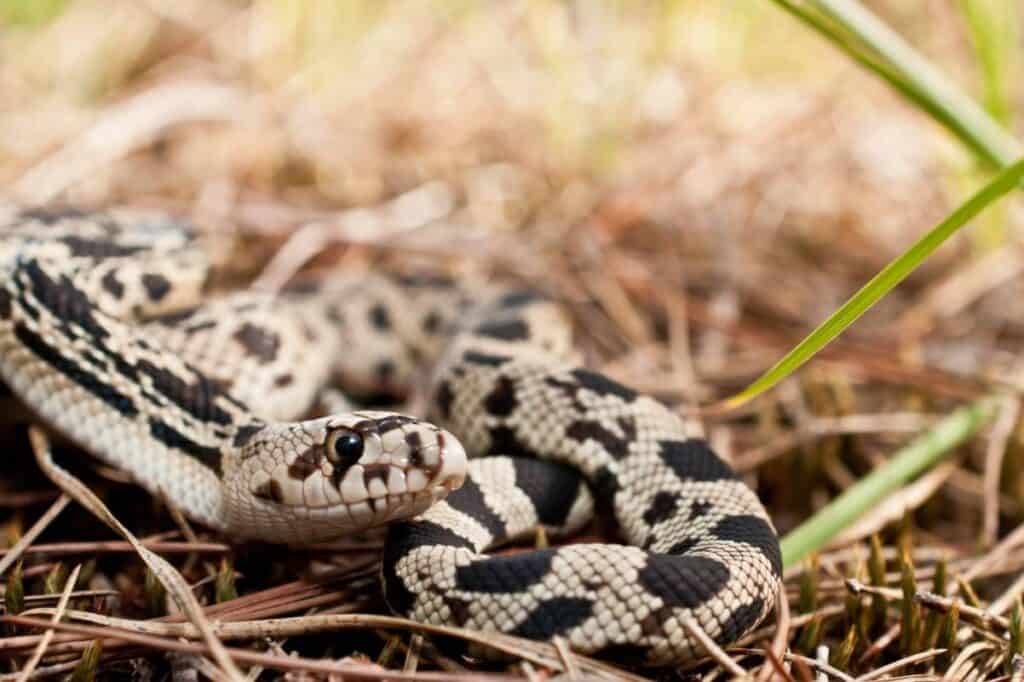
| Species: | Pituophis melanoleucus |
| Longevity: | 15 to 20 years |
| Good to own as a pet?: | Yes |
| Legal to own?: | Yes |
| Adult size: | 6 feet |
| Diet: | Rodents, small mammals, birds, and eggs |
While the Outer Banks kingsnake can reach an impressive 5 feet in length, the northern pine snake puts that number to shame by reaching 6 feet in length.
These snakes are opportunistic feeders that eat rodents, small mammals, birds, and eggs. Their large size and potentially docile nature make this an extremely impressive pet.
Still, while the northern pine snake means you no harm, they are powerful constrictors, so you need to be careful when handling them.

Conclusion
While there are 37 known snake species in North Carolina, the good news is that only six of them are venomous, and of those six, only one is common.
The chances of you running into a venomous snake on your next outing is small, but not impossible, so you should know what to look for! If you see a non-venomous snake, pause to admire them, but keep in mind that they can still bite if you get too close!
Featured Image Credit by joolsthegreat, Pixabay
